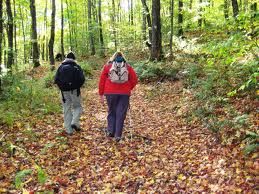Environment
Nature and Recovery
How your connection can help you to heal from addiction and mental health issues
Posted October 16, 2012

Nature: from an urban garden and park to the vast lakes, rivers, oceans, forests and mountains—it is everywhere and available to everyone. There are unique and healing qualities that civilizations have tapped into since the beginning of time. However, our society seems to emphasize the complete opposite- technology and electronics. The key to recovery and life in general is “balance” and therefore, it is important for our mind, body and spirit to counteract our high-tech lives with nature. I have been reading the book “The Nature Principle” by Richard Louv and have been overwhelmed by the relevance of this book and the ideas within in it as they relate to those in recovery from both mental health and addiction issues. Louv states that nature provides healing for our mind and body, that Vitamin “N” (nature) should be in everyone’s diet and that “some of our society’s hunger for drugs may be related to our yearning for this unified state of mind, body and nature”. When individuals drink alcoholically, they are disconnected from their environment and their senses are shut down. Therefore, healthy recovery can be an awakening of the senses and mindfulness of your surroundings.
Therapeutic wilderness programs have long recognized the healing qualities of nature. In speaking with Tracy Edwards, Executive Director of the former Adirondack Leadership Expeditions program for adolescents in Saranac Lake, NY, you can feel her passion towards nature and the positive effects on adolescents. She explains that she personally lives a nature-based “lifestyle” and is overjoyed to share this with her clients. She acknowledged that there is a “spiritual side of nature” and that clients are “unplugged” when in their program. Therefore, they become “raw, vulnerable and uncomfortable” but that this opens them up for healing. Tracy emphasized that being in nature can teach individuals that you can “find a high, a rush on the water, hiking or mountain climbing” and this can often help in the prevention or treatment of addictions.
The evidence of the effectiveness of these programs is demonstrated both from personal anecdotes as well as from research studies conducted by Aspen Education Group with clients and parents at admission, discharge and during 6 and 12 month follow-ups. The research indicated that attending Aspen Outdoor Behavioral Health programs reduced stress, depression and anxiety in teens and that there was continued reduction at the 6-month follow-up assessment. Substance-related issues were reduced from the “significant to elevated” range to a “normal” range upon graduation and up to 12-months. Additionally, the organization Outdoor Behavioral Healthcare Research Cooperative (OBHRC) has a comprehensive collection of research and data on the positive and healing effects of wilderness therapy www.obhrc.org. Other types of nature-based therapeutic modalities include adventure-based counseling and experiential therapy. For example, the O'Connor Professional Group in the Boston, MA area has included Experiential Therapy into their Intensive Case Management services and this can include rock climbing, hiking etc. www.oconnorpg.com Located in the Berkshire Mountains, The Mountainside Treatment Program in Canaan, CT has a "Mind, Body, Spirit" philosophy, sophisticated clinical component, encorporates the wilderness into client's treatment and has recently added "The Voyager" high ropes challenge course to allow clients to experience a "natural high" www.mountainside.com. Turning Point extended care treatment for young adult men in New Haven, CT integrates wilderness trips (skiing, hiking) into their programming as a way for residents to bond, connect with the outdoors and associate sobriety with healthy activity www.ctdrugtreatment.com.
Ray Barlow, LSAC is the Co-Founder/Program Director of Legacy Outdoors Adventures www.legacyoutdooradventures.com wilderness program in Loa, Utah that specializes in treating teens age 16-17 and young adults. The following interview with Ray illuminates the magic of nature and how lives can be transformed from this connection:
1. What are the healing qualities of exposure to nature that you have observed in your work with clients who have addictions?
There is a healing power in nature that cannot be measures nor explained, yet it is very real. Time in the wilderness seems to have a healing effect on even the deepest wounds. It is no coincidence that most of the spiritual leaders and teachers throughout time have gone to the wilderness to find healing and purpose in preparation for their life’s work. One of the gifts of the wilderness is the way it gives us an honest look at ourselves, our gifts, talents, weaknesses, character defects and our true potential are all made obvious. It is this honest look at ourselves that allows us to find love and acceptance for who we are and a vision of who we can become.
2. What are the benefits of wilderness programs for client’s recovery?
Wilderness programs help a client’s recovery by restoring their self-confidence and self-efficacy. They begin to believe once again that they can be successful in life. Simply put, the experience helps them to recapture hope in their lives.
3. Are there ways that you would suggest those in recovery integrate nature into their lives when living at home?
The use of a journal to record the wilderness experience can be a powerful tool to help one connect with that experience and the lessons learned. Meditation can also be a powerful way to connect with the wilderness even if there is very little wilderness available to someone. It is also important to plan and schedule opportunities to reconnect with nature, evaluate progress, and direction.
4. What personally lead you into the field of wilderness treatment?
As a young man struggling with the loss of my parents and dealing with my own addictions, anger and fear. I retreated to the wilderness in search of relief from the pain of life and answers to my deepest questions. Through a powerful experience that cannot be fully explained or measures I found purpose and direction in my life. I came to understand that I had gifts to give and that I could overcome my weaknesses and find joy in life. I now have the blessing and responsibility to help give others the same opportunity.
It is easy to get immersed in our day-to-day tasks of life, work and family and to practice spirituality in a compartmentalized manner. I have personally noticed that my racing mind instantly quiets down when I am outside and being truly mindful of the trees, leaves, sky, pond, ocean, forest. Keeping this in mind, I have been making more of an effort to immerse myself in those environments—and am feeling a sense of renewal, peace and calm in my life. What we focus on manifests, and it is important to be aware of what we target our attention towards and how we feel before, during and after. Simply observing my own mood and sleep over the past week of increased nature awareness and exposure has made it clear that I should continue to expose myself on a daily basis in some form.
In a 12-Step program connecting with nature could be considered a form of practicing the 11th Step or “Sought through prayer and meditation to improve our conscious contact with God as we understood Him, praying only for knowledge of His will for us and the power to carry that out.”, in SMART Recovery this may be considered “Relapse Prevention: Activities You Might Enjoy” and a form of healthy distraction. Many of my clients report that they feel most connected to their Higher Power when they are in nature. Even those who identify themselves as agnostic will often agree that they are aware of this connection.
You do not need to be Henry David Thoreau and move into the woods in order to experience nature. So how can you integrate nature into your life, even if you live in an urban area?
1. Garden—even small window boxes or vertical garden plants
2. Visit your local parks
3. Pot plants on your porch and in your house
4. Get a pet (even a goldfish!)
5. Research local wilderness/outdoor club and groups (ie, Exploring a Sense of Place www.exploringsenseofplace.org, Children and Nature Network http://www.childrenandnature.org/directory/clubs/ Audubon Society http://www.audubon.org/search-by-zip Sierra Club http://www.sierraclub.org/chapters/
6. Join a “meet-up” group focused on outdoor activities (they can be located locally online on Websites like www.meetup.com, and others are connected to outdoor sports-related businesses such as running stores, bicycle stores, REI, EMS, etc.)
7. Go outside with your children and walk, hike, swim- you will all benefit!
8. When using your computer, try sitting outside or near a window
9. Read and write about the topic
10. Take a “nature break” at work and make a point of getting outside
11. Get certified as a “citizen naturalist” through the National Wildlife Federation
12. Research books about local hikes wherever you are located, such as “60 Hikes within 60 Miles Boston” http://www.amazon.com/Hikes-Within-Miles-Including-Hampshire/dp/0897326…
13. Spend time at to your local beach, lake, pond or river, it is worth the travel time!
14. Take a “mindfulness” walk and focus on each of your 5 senses and observations of the natural environment
15. Locate wildlife and land preserves in your state, go to their Websites and possibly become a member of the organization (ie, in Massachusetts The Trustee of Reservations www.thetrustees.org and the national Audubon Society www.audubon.org )
16. Identify outside activities that you can engage in each season (Summer- beach, Fall- hiking, Winter- snow-shoeing, Spring- more hiking!)1``
17. Final suggestion…get off of your computer now and go outside!
For more information and resources about high-functioning alcoholics, please visit www.highfunctioningalcoholic.com




